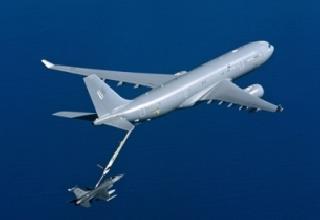
WASHINGTON (BNS): US President Barack Obama has put forth a budget proposal of USD 495.6 billion for the Defence Department (DoD) to fund base defence programmes in fiscal year 2015.
The proposed budgetary spending, announced on March 4, is $0.4 billion less than the enacted FY 2014 appropriation and is consistent with the current budget caps, Pentagon said.
The Opportunity, Growth, and Security Initiative -- a government-wide initiative -- requests an additional USD 26 billion in FY 2015 to address significant readiness and modernisation challenges.
While the Air Force (USAF) has sought a topline budget of $109.3 billion to support a total force end strength of 483,000 personnel and protect its top recapitalisation priorities -- the KC-46A Pegasus, F-35A Lightning II Joint Strike Fighter and the Long Range Strike Bomber, the Navy has proposed a spending of $148 billion which also includes the Marine Corps.
The USAF budget proposal seeks to divest the U-2 spy planes in favour of the Global Hawk long-range UAV to carry out intelligence, surveillance and reconnaissance missions. It also intends to retire the A-10 Thunderbolt II attack aircraft in favour of multi-role fighters that can better survive in contested environments.
The proposed spending by the Navy, with an increased focus on its forward presence and continued efforts in making critical investments in people and future capabilities, calls for providing money for ship steaming, flight hours, maintenance and base operations.
It also funds amphibious ready group and carrier strike group deployments, supports the three ballistic missile defense (BMD)-capable destroyers joining the USS Donald Cook (DDG 75) in Rota, Spain, in FY15, and provides continued support for the rebalance to the Pacific, with $46.8 billion overall in operations and maintenance.
The Navy has requested $38.4 billion for ship, aircraft, weapons and other procurement programmes including the Littoral Combat Ship, P-8A Poseidon aircraft, Virginia class submarines and the Mk-48 heavy weight torpedo.
The Army, for its part, has requested a budget amout of $121 billion to sustain a force level of 440,000 to 450,000 personnel -- a reduction from its current end strength of about 510,000.
"When combined with the Marine Corps, these end strength numbers will be sufficient to meet the needs of the President's defence strategy, including capability to decisively defeat aggression in one theater, while defending the homeland and supporting air and naval forces in a second theater. There will, however, be somewhat higher risks at these force levels, particularly for missions involving multiple and simultaneous conflicts," Pentagon said.
To maintain a balanced force, the Army National Guard and Reserves will also draw down, reducing to 335,000 Guardsmen and 195,000 Reservists, it said.
The Army's Ground Combat Vehicle programme has been terminated and alternative options are being evaluated. Changes are also planned for the helicopter force.
The aging Kiowas (helicopter) will be retired and replaced with National Guard Apaches and Lakotas. In return, the National Guard will receive the more versatile Blackhawks, the DoD said.
The strategic Missile Defence Agency (MDA) has requested a spending of $7.459 billion "to develop and deploy interceptors, sensors, and command and control, battle management and communications (C2BMC) systems that constitute the Ballistic Missile Defence System (BMDS) to provide US homeland defence and regional missile defence for deployed forces, allies, and friends."
The agency has sought an amount of $99.5 million to initiate the redesigning of the exo-atmospheric kill vehicle (EKV) for the Ground-based Midcourse Defence (GMD) system.
 Previous Article
Previous Article Next Article
Next Article












The Indian Air Force, in its flight trials evaluation report submitted before the Defence Ministry l..
view articleAn insight into the Medium Multi-Role Combat Aircraft competition...
view articleSky enthusiasts can now spot the International Space Station (ISS) commanded by Indian-American astr..
view article